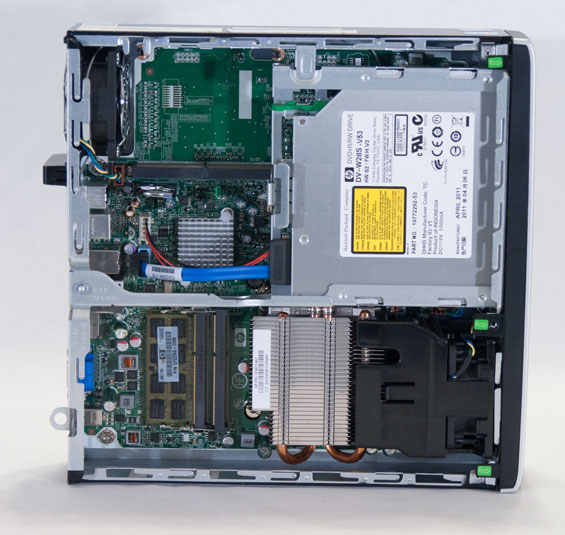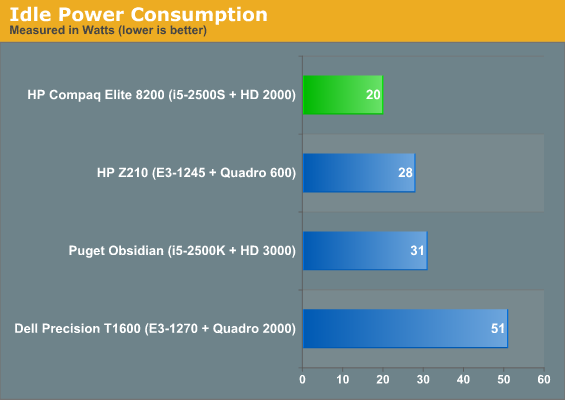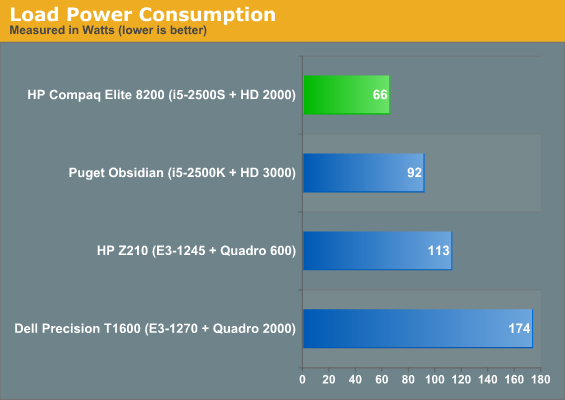HP Compaq 8200 Elite Ultra-Slim: The Littlest Desktop
by Dustin Sklavos on September 29, 2011 10:40 AM EST- Posted in
- Systems
- IT Computing
- HP
- SFF
- Enterprise
Build, Noise, Heat, and Power Consumption
Once again I have to state that I'm a big fan of how enterprise-class computers are built, specifically in regards to internal layout. Because these machines are designed to be easily serviced should the need arise, there are really quite a lot of intelligent ideas that go into how they're built that make me wonder why we don't see them more often on the consumer side. Take a look inside the wonderfully small HP Compaq 8200 Elite Ultra-Slim.

Everything is in its right place and extremely easy to service. Due to the smaller form factor, HP opts for mainly notebook parts inside the 8200 outside of the 65-watt processor. There's a substantial heatsink complete with copper heatpipes covering the processor, and a fan from the front channels air straight through it and out of the back of the case, cooling the memory in the process.
When I opened the 8200 the first time I was surprised to see the relatively large empty space in the top left corner; that MXM slot is actually there in case the system is custom ordered with a graphics upgrade, which can be cooled by the second small fan. The catch as noted earlier is that the only graphics upgrade available is an AMD Radeon HD 5450. Given the nature of this desktop, we can't say that upgrade is really worth it.

Considering the low power components of the 8200, it should come as no surprise that the system runs quietly and stays reasonably cool. The CPU temperatures aren't stellar (though they're still better than most notebooks we test), but this is also a very small enclosure, and HP has largely erred on the side of silence rather than performance. Since Sandy Bridge is already a cool-running architecture to begin with, this winds up being the right trade. Air circulation within the chassis also seems to be good enough to keep the 2.5" Western Digital Scorpio Black running cool.


Other than pure size, power consumption winds up being the 8200's trump card. With load power of just 66 watts, it's not hard to see why a business might want to deploy several of these for users who don't need extremely high-powered hardware. Idling at the desktop, it consumes a miserly 20 watts.














41 Comments
View All Comments
Alurian - Thursday, September 29, 2011 - link
Think that processor only has 6M of L3:http://ark.intel.com/products/52211/Intel-Core-i5-...
JarredWalton - Thursday, September 29, 2011 - link
Fixed, thanks.JKolstad - Thursday, September 29, 2011 - link
While it's not strictly required by the DisplayPort standard, I'd bet you a nickel that HP's implementation of DisplayPort includes the "DVI compatibility" dual-mode that'll let you use a <$10 cable adapter to connect from DisplayPort to a DVI (or HDMI, for that matter) monitor.(Every HP I've seen with DisplayPort so far has supported this option. There's supposed to be a little "DP++" logo when dual-mode is supported, although I can't tell from the picture if it's present or not.)
JarredWalton - Thursday, September 29, 2011 - link
I think the point is that most people would just as soon avoid using the extra adapter -- I know I would. It makes for a clunky connection when you have to go DP -> DVI (or even worse, DP -> DVI -> HDMI). I also like being able to screw in DVI cables when I know the system isn't going anywhere -- I've done support for a company where I got more than a few calls that ended up being a cable that came loose when someone decided to rearrange their desk.MadAd - Friday, September 30, 2011 - link
but you know vga and dvi are end of life already, take the pain now, dp is the futurei just wish manufacturers would hurry the hell up with it, i mean was it too much to ask all these years for a simple digital connector that carried sound?
Sure its a pita having to restock the connector/patch cable box but thats the price of progress, infact i wish theyd go with miniDP all over, but ppl seem to like huge connectors, same with miniusb.
JasperJanssen - Wednesday, October 12, 2011 - link
DP cables aren't screwed, but they have tangs that lock the cable at least as securely in place (until you press the button on the connector). Certainly the DP->DVI adapters in use at my workplace have those, and the DVI cable can screw into the adapter.DP is a lot smaller than DVI on the backplate, and DP is cheaper to license. This way the DVI licensing cost gets passed off to the adapter, and people who don't use it (because they're still razzinfrassin using VGA monitors exclusively) don't pay it.
biostud - Thursday, September 29, 2011 - link
Not that detailed about the sound emission in the review.With a 5450 could it be a very good HTPC?
JarredWalton - Thursday, September 29, 2011 - link
Dustin's SPL meter can't accurately measure under 40 dB I believe, making it useless for many systems unfortunately. He also lives in an area with quite a bit of traffic, which can make it doubly hard to get meaningful noise measurements. (And no, he doesn't have an anechoic chamber -- neither do I nor most of the other reviewers here.) I'll see if I can get him to post a noise level for full load, or at least a bit more detail, but at least for the base design it's going to be very nearly silent at idle and probably not much louder under load.jdonnelly81 - Thursday, September 29, 2011 - link
I had a similar thought. Though the form factor is appropriate, I think the connectivity in audio and video limit it's practicality.Belard - Thursday, September 29, 2011 - link
So... its basically a notebook computer without the notebook... er screen and keyboard.